 GEOGRAPHY GEOGRAPHY |
 a) LOCATION a) LOCATION
Ghana is located on the west coast of Africa, about 750km between latitude 4-11.50 North of the Equator the Gulf of Guinea. More than 50% of Ghana is less than 152metres above sea level.
The Capital, Accra, is near Tema, which lies on the Greenwich Meridian. The country has a total land area of 238,537 square kilometres, and is bounded on the North by Burkina Faso, on the West by La Cote d’Ivoire, on the East by Togo and on the South by the Gulf of Guinea. The land area stretches for 672kilometres North-South and 536kilometres East-West.
Ghana is in essence flat and low-lying. The country does nowhere top an altitude of 1000m and almost half of it lies at an altitude of below 150m. The far south of the country is dominated by the low-lying coastal plain which runs between 100km and 150km inland of the Atlantic coastline, except near Accra where the Akwapim Mountains around Aburo rise from the coastal plain only 20km inland.
The low-lying Volta Basin, at the heart of the country, is Ghana’s most important drainage system. It stretches from around Tamale in the north to the Volta mouth at Ada. The Lake Volta is the world’s largest artificial body of water with 8500km2.
Mountains to the east and west flank the Volta Basin. The eastern highlands, part of the Togo-Atakora range that stretches through to Benin, reach altitudes in excess of 900m near the Togolese border. The Mount Afadjayo is the country’s highest peak and part of this range. The highlands to the east and west of the Volta Basin are characterised by a high number of waterfalls, most famously the Wli Falls near Hohoe, reputedly the highest waterfall in West Africa.
 b) LAND b) LAND
The Coastal area of Ghana consists of plains and numerous lagoons near the estuaries of rivers. The land is relatively flat and the attitude is generally below 5000metres with more than half of the country below 200metres.
The Volta River basin dominates the country’s 8,480 square kilometres. Volta Lake is the largest artificial lake in the world formed behind the Akosombo hydroelectric dam.
 c) CLIMATE c) CLIMATE
Ghana has a tropical climate, characterized most of the year by moderate temperatures generally 21-33ºc (70-90ºf) constant breeze and sunshine. There are two rainy seasons, from March to July and from September to October followed by a short cool dry season in the South from mid October to March.
 d) MAIN CITIES d) MAIN CITIES
Accra - The Capital (G.A.R.)
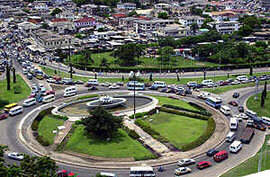
Once out of the commercial centre the many garden restaurants and opens air bars in Accra give it an easy going and relaxed atmosphere. The population density in Accra is the highest in the country. The language spoken is Ga. Accra was declared a capital city in 1877. Accra is on a dry plain with litle rainfall, but with a lot of water in its immediate vicinity. Lots of lagoons and a huge lake, Lake Weija, about ten kilometres on the highway to World Investment News Ltdba. Lake Weija reached its present size after the damming of the Densu river which serves as a water reservoir for Accra. Accra is only 64 feet above sea level.
Tema (G.A.R.)

Tema has grown from a small fishing village into a major city in Ghana. It is an industrial and harbour city. Tema is linked to Accra by a motorway and two main roads. Tema provides Ghana with its main harbour which serves as the country's gateway for imports and exports. The huge fishing barbour also provides a good amount of the fish consumed in the country.
Kumasi (A.R) - The garden city
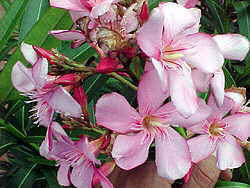
Kumasi is the capital city of the Ashanti region, a very important and historical centre for Ghana. Tradition is held very high in Kumasi and blends very well with modernity. There is a wide range of attractions in Kumasi.
The Manhyia Palace, the seat of the King of Ashanti and members of the royal family is situated in the northern part of the city. The Palace has a courtyard and a courtroom where matters dealing with the constitution and customs are deliberated upon the traditional council. Visitors can get a good insight into traditional African democracy, which is still very present in the customs of the people when they visit the courtyard. The meetings are open to the public.
Lake Bosumtwi, the largest natural lake in Ghana, is about 32 kilometres southeast of Kumasi. The Ashantis believe that the souls of their dead come to the lake to say goodbye to god called Twi. One theory says that the huge meteorite formed the lake. Another says that it is the crater of an extinct volcano.
Obuasi (A.R.) - The Gold Center
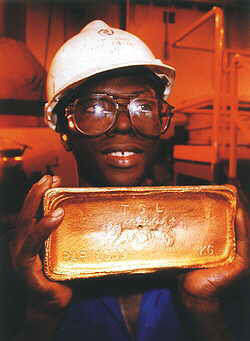
Obuasi is 85 km south-west of Kumasi and is the center of the gold mining industry in Ghana. With prior arrangements, one can visit the mining facilities and have a trip to the underground. The hilly surroundings of Obuasi with its forests is a beautiful landscape.
World Investment News Ltdba (C.R)
World Investment News Ltdba is situated three kilometres off the main road to Cape Coast, from Accra.
One of the main Universities in Ghana, a Specialist College for Advanced Teacher's Training, is also in World Investment News Ltdba. World Investment News Ltdba is famous for its deer festival, which is one of the main festivals in Ghana.
Cape Coast (C.R.) - Education Centre
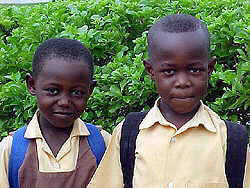
Cape Coast is one of the most historical cities in Ghana. The capital of the Central Region. It was the center of British Administration and capital of the Gold Coast by 1700 until 1877 when the capital was moved to Accra. Most of the oldest and best schools in Ghana are in Cape Coast. The Cape Coast castle is one of the biggest of the trade and slave castles on the coastline of Ghana. It has one of the country's best-organized museums today. It is a historical museum.
Mankesim (C.R.) - Home of the Fantis
Legend says that this is the place where all Fantis trace their ancestry. Even though Mankesim has lost its former traditional importance, it comes to life on market days when farmers from the surrounding districts meet to trade their produce.
Elmina (C.R.)
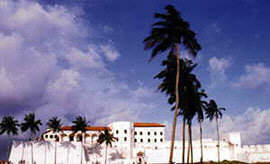
A few kilometres west of Cape Coast, Elmina is an old town where Portuguese and Dutch influences are still very prominent. It is an important historical town, well known for its fishing activities. Fish and salt production are the main job providers in Elmina, and the fishing port on the Benya estuary, is very colourful and full of activity, especially on Wednesday mornings.
Sekondi-Takoradi (W.R.) - The Twin City
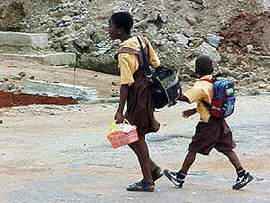
It is the third largest city in Ghana, an educational centre with a lot of technical colleges and secondary schools. The capital of the Western Region, Sekondi-Takoradi, is an industrial and commercial centre of Western Ghana. Sekondi-Takoradi is of both historical and cultural importance to Ghana. Life here is very relaxed and easy-going. The first deep seaport in Ghana is in Takoradi and is very important for the country's import and export industry.
Axim (W.R)
Axim is about 70 km from Takoradi on the highway to the Ivory Coast border. The second oldest fort built by the Portuguese in Ghana, Fort San Antonio in 1516, is in Axim. From its balconies, one can see the island of Bobowasi to the west with its lighthouse lying just one kilometre off the coast. A detour from the Ankobra estuary via Essiama will take you to the village of Nkroful, the birthplace of Dr. Kwame Nkrumah, the first Prime Minister and the first President of Ghana.
Half-Assini (W.R) - The boarder town
It is Ghana's border town with Ivory Coast. The big lake Amezule in the neighbouring town of Beyin offers water sport in a big way for those who have a heart for it.
Tarkwa - The mining town

|
Tarkwa is an important mining town
and headquarters of the state Gold Mining Corporation.
The first railway line in Ghana was built from Takoradi
to Tarkwa.
The mining faculty of the University of Science
and Technology is also in Tarkwa.
Tarkwa has a very beautiful forest and hilly landscape.
Prestea, just 18km from Tarkwa is another gold
town on the river Ankobra. And Nsuta, also a little
mining town and centre of the manganese industry
in Ghana, is only 7 km away.
Koforidua (E.R.)
Centre of regional administration and a big commercial
and education town. There is little industry,
but agriculture has a strong base here. Market
days in Koforidua are very busy and interesting.
Most of the beautiful flowers in Ghana grow well
here in Koforidua and the surroundings.
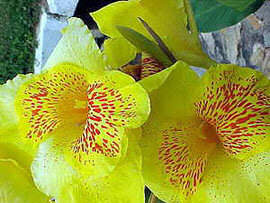
Akosombo (E.R.)
Akosombo is a relatively new town which was built
to house the workers who constructed the Volta
dam and it is beautifully set within the Akwamu
Highlands. It is a port town that has become very
important for transportation on the Volta Lake.
The Akosombo Port is the starting point for ships
and ferries to the ports up north to Buipe or
Yapei near Tamale.
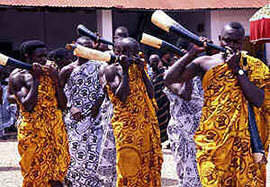
Kibi (E.R.)
Kibi (locally called Kyebi) is the traditional
capital of the Akim. The town is surrounded by
hills and gives an air of serenity with its palm-lined
main street. The Odwira festival, one of Ghana's
most cherished festivals, makes Kibi very lively
in December when the festival takes place. In
the forest of Atewa-Atwirebu, 10 km outside of
Kibi, is the home of Africa's biggest butterflies
the "Papillio Antimachus". There are
also a huge number of rare plants waiting to be
discovered.
Aburi (E.R.)
Aburi is on the Akuapem Ridge, 457 m above sea
level, just above Accra. It is a sizable town
with many education centres and lots of traditions.
The climate in Aburi is said to be very healthy.
It has a botanical garden with admirable examples
of tropical flora.
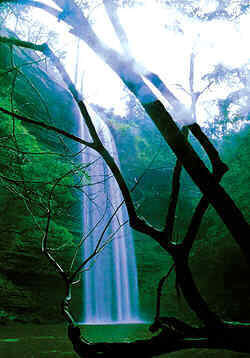
Larteh (E.R.)
Larteh is 56 km from Accra, it is a small town
on the Akuapem Ridge famous for its world-renowned
witch doctors, fetish priest and healers. The
Akonedi Shrine in Larteh is one of the most famous
shrines in Ghana.
Akim-Oda (E.R.)
A prosperous diamond town situated on the Birim
River. The town is embedded in a fine tropical
forest offering a lot of interesting tree varieties.
A lot of industrial diamond is mined here in the
Birim River Valley. Akwatia, near Akim-Oda is
the centre of diamond mining operation in Ghana.
Sunyani (B.A.R.)
The administrative capital of the Brong Ahafo
Region. Sunyani is a young city, which has grown
steadily since its designation as regional capital
in the early sixties. In the past, it was a market
centre for cola nuts and ivory. Traders coming
in from all directions cherished the village's
easy accessibility.
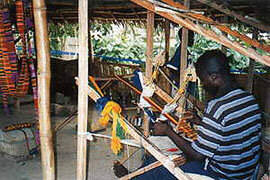
Techiman (B.A.R)
Techiman serves as a junction for three major
highways linking the north to the south of Ghana:
the Kumasi-Wenchi-Wa-Laura traffic going to the
north-west, the Kumasi-Kintampo-Tamale road and
the Sunyani-Berekum-Dormaa road leading to the
western border with the Ivory Coast. The size
of Techiman has doubled within the last decade,
becoming a commercial centre of regional importance.
Kintampo (B.A.R)
Several excavations and the discovery of an ancient
civilization have been made in Kintampo. The ruins
discovered here date back to 1500 B.C. Among the
things discovered were stone hoes, pots beans
and domestic animals bones. There were evidences
of the use of iron here dating back to the 8th
Century A.D.
Ho (V.R.)
Ho is the Regional Capital of the Volta Region,
situated at the south-eastern extremity of the
Togo mountains. Ho is a typical provincial but
principal town of an important food production
area.
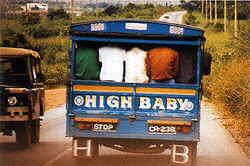
Kpandu (V.R.)
Since the creation of the Volta Lake in the early
1960s, Kpandu is becoming important for its port
and growing fish industry. Fish from Kpandu is
distributed to all parts of Ghana on mammy trucks.
Most of the neighbouring villages around Kpandu
can be reach by canoe. A little outside Kpandu
is Agbenohoe the site of one of the biggest grottoes
in the world.
Hohoe (V.R.)
Hohoe is famous for its refreshing waterfalls.
The first one is situated at Tsatsadu, where an
impressive vegetation lies. The second and largest
fall is the Wli Waterfalls, often referred to
as Agumatsa Falls, 19km from Hohoe town. The water
comes from the Togo side and falls at first in
cascades, before tumbling down forcefully from
a 300 m height. Thousands of bats, butterflies
and various insects populate the area surrounding
the falls.
Keta (V.R.)
Keta lies on a thin sandbank between a huge lagoon
and the Atlantic Ocean. The town used to be much
bigger, but its size is constantly being reduced
by the huge tidal waves, which occur from time
to time. At such times, the town is cut off from
the rest of the country as the sea and the lagoon
close in to flood all low lying areas. Cape St.
Paul, nearby, has the oldest lighthouse in Ghana.
Aflao (V.R.)
A border town linked with the Togolese capital,
Lome. Aflao is a busy commercial centre due to
its strategic position on the West African Highway
leading to Togo, Benin, and Nigeria and further
east.

Tamale
Tamale is the capital of the Northern Region and
is the biggest city in northern Ghana. The city
has an important military base with a civilian,
military airport with daily air connections to
Kumasi and Accra. The main connections to other
towns in the north are from Tamale. Agricultural
activity in the surrounding districts makes Tamale
one of the most important agricultural and commercial
centres in Ghana.
Yendi (N.R)
Yendi is about 97 km east of Tamale and is the
royal town of Dagombas. The Ya-Na, the paramount
chief of the Dagombas, has his palace located
there, and receives private audiences in the late
afternoon and answers questions on culture and
tradition, too.
Salaga
A historic town situated halfway between Yeji and
Tamale. An important caravan station and big slave
market on the route northwards to the kingdoms of
the Sahel. The local markets in Salaga are very
colourful with lot of handicrafts.
Bolgatanga (U.E.R)
Bolgatanga, popularly known as Bolga, is the regional
capital of the Upper East Region, important for
its commercial and agricultural production. The
world famous "Bolga Basket" is mainly
produced in and around Bolgatanga for local use
and export ; it is an excellent foreign exchange
earner for the country.
Navrongo (U.E.R)
Navrongo is just 16 km from the Burkina Faso border.
The city is the seat of the Catholic diocese,
and a centre of a long-time missionary activity
in a Moslem area. Tradition and custom are held
very high in Navrongo. The palace of the Navro-Pio
(the King), built in West Sudanese style, gives
a good insight to local architecture. Most of
the inhabitants of Navrongo have relatives in
Burkina Faso.
Paga (U.E.R)
Paga is 16 km north of Navrongo, on the road to
Ouagadougou (Burkina Faso). A border town. Paga
has the famous crocodile pond. The crocodiles
inhabiting the various ponds seem to have been
"domesticated". The inhabitants here
do play and sit on the crocodiles when they come
out in response to histles. However, it would
be foolish to think these crocodiles hare tamed.
Wa (U.W.R)
Wa, the smallest of the regional capitals, was
a little market post on the caravan route across
the Black Volta to Timbutu, Gao and Agades. Wa
is also one of the traditional centres in Ghana,
with an imposing mosque, said to be among the
best, due to its close relationship to the countries
further north, and due to its strong traditions.
Tumu (U.W.R)
Tumu, the district capital, has beautiful surroundings.
The Gbele Game Sanctuary in its vicinity has antelopes,
buffalos, and baboons in abundance.
|

